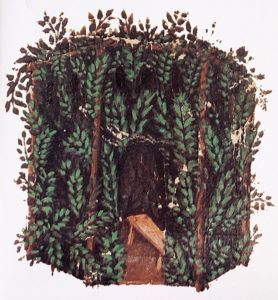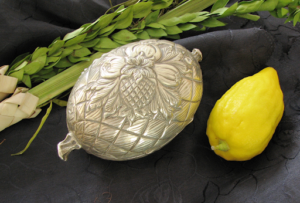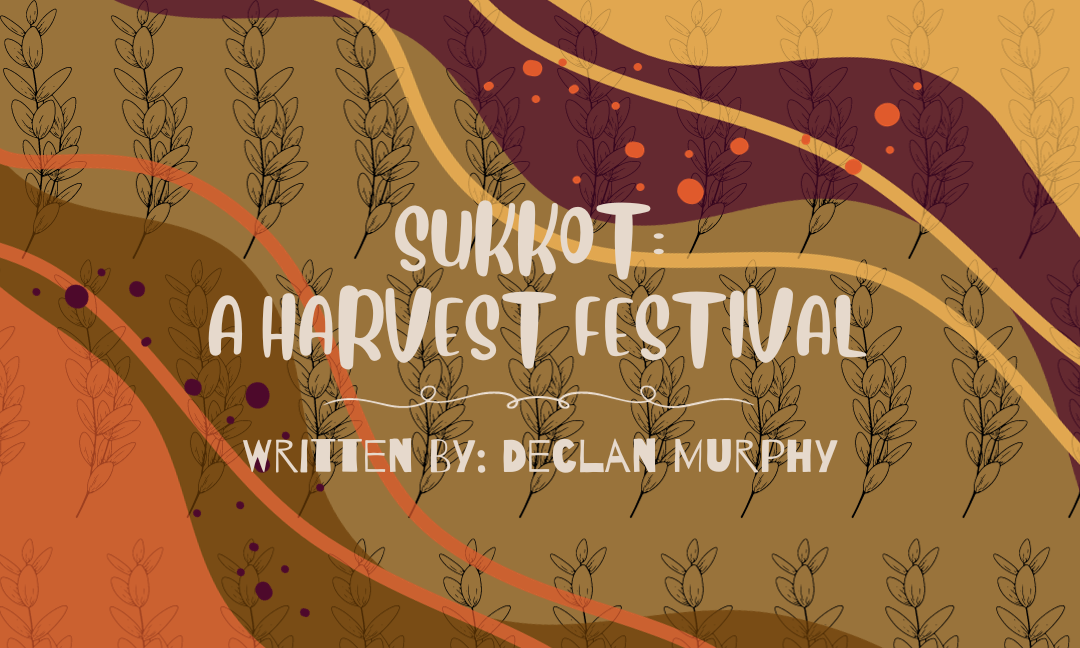Written by Declan Murphy
Edited by Fatima Khan
Designed by Maahi Jain
Published by Kiritika Rana
Sukkot (the “festival of booths”) is a Jewish fall festival with deep roots in the growing season and its cycles. It’s filled with food and the celebration of nature, and aims to get people outdoors and in touch with the land (and water) that produces their foods.

In terms of the biblical narrative, the holiday of Sukkot commemorates the booths or tents that the Israelites lived in during their wandering after leaving Egypt in the famous story of the Exodus (which is commemorated by the better known Jewish holiday of Passover in the spring). Historically, it was also a time of pilgrimage during which Jews would travel to the Temple, carrying their tents with them.
Other than that, however, Sukkot is one of the only Jewish holidays that doesn’t directly mark a specific historical event. The reason for this absence is that Sukkot is linked to the earth as much as it is linked to history – Sukkot is a harvest festival! Like Thanksgiving, Sukkot focuses on celebrating the bounty of agriculture and nature by eating with friends and family, as well as by marvelling at the beauty of food.
In fact, food is not only consumed at Sukkot, but makes up the majority of decorations for the holiday, as well. Along with flowers, branches, leaves, and other plant materials, gourds and other food items are used not just for their nutrition, but also for their aesthetic value, as we see with the lovely Samaritan sukkah pictured below.

The sukkah (a “booth” or tent in the singular) is the distinguishing feature of Sukkot (the plural of sukkah). For about a week, Jews are supposed to live (and especially eat) in the sukkah their family or community has constructed together. Building the sukkah and making it comfortable and appealing can be a fun family activity that allows everyone to express themselves through their artful decorating. Inviting guests into the sukkah is a part of the holiday, as it is also a celebration of hospitality and sharing food and drink with others.
Jews are required to at least eat a small piece of bread in their sukkah; this is the minimum requirement for celebrating the holiday. Most Jews only eat and possibly hang out in the sukkah for a while, at least for the first two nights, but some Jews do so the whole week, and some even sleep in theirs!
Each day of Sukkot, a bundle containing a palm frond (lulav), three myrtles (hadasim), two willows (aravot), and a citron (etrog), are held during a blessing. These represent the “four kinds” or species of plants (the arba minim) that the book of Leviticus commands Jews to wave on Sukkot each year. Interestingly, while the myrtle, palm and willow were native to the areas of Canaan, the etrog (a very old species of citrus that looks like a large, lumpy lemon, as seen below) comes from China. It seems the etrog slowly became absorbed into Sukkot’s tradition through trade with the far east via the Persians, so the item hints at how old the history of importing foods is for humans.

But the etrog and decorative fruits are not the only foods that play a role in Sukkot! Food, and eating, is central to the festival.
Eating together and feeding guests are a major part of how we celebrate Sukkot. Unlike most other Jewish holidays, there are no specifically mandated foods to be eaten for Sukkot, other than some grains. Almost all Jews eat bread (made of grains) during Sukkot, especially the traditional braided bread, Challah. Otherwise, foods typically eaten on Sukkot vary from family to family, as they depend a lot on their local geography and climate. For example, Jews living in North America often eat “fall foods” like squash soup, roasted carrots, pumpkin pie, and apple cake, while Jews in North Africa might eat tagine with couscous and a salad, with dates or figs and olives.

Many Jews around the world eat “stuffed foods,” or food stuffed with other foods, such as stuffed peppers or mushrooms, as well as desserts like strudel and doughnuts. According to tradition, the stuffed foods represent the way in which the family is taking shelter in the tent, but it’s common to joke that it also represents how “stuffed” you are after dinner!
In addition to the celebration of food and the harvest, Sukkot is also a celebration of water, an element deeply connected to being mindful about food. Sukkot gives us a chance to be grateful for wells, fresh water reserves, and especially the rain, without which we couldn’t live. Historically, Sukkot marked the beginning of the rainy season, which was vital to the Israelites.
Sukkot contains a separate segment called Simchat Beit Hashueva (“Rejoicing at the Place of the Water-Drawing”). In ancient times, this involved making a joyful, grateful offering of water at the Temple every morning of Sukkot. Today, it is marked by a communal party, including drinks, dancing, music, and singing, and expresses joy at having sufficient water to drink and to grow crops. It also expresses hope that we will enjoy another year of water. Today, many Jews use this as an occasion to teach their children about water conservation and protection, highlighting how essential water is to our lives and the responsibility we have to keep it safe.

Therefore, Sukkot has remained a time to reflect on food and water, and the environment, for both traditional and less traditional Jews. It is a time for us to admire the foods we eat and be grateful for the water we have. It’s also a good time to commit to keeping our food and water systems clean and healthy for future generations to come.
This year, the festival of Sukkot begins the evening of Friday, September 29, 2023 and ends at nightfall on Friday, October 6, 2023.
Does your culture or community have any special ways to mark the harvest season? Feel free to share them in the comments below!
Sources:
Anon. (n.d.) Sukkot – Wikipedia
Anon. (n.d.) Simchat Beit HaShoeivah – Wikipedia
Anon. (2017.) The Four Species of Sukkot Explained | Tel Aviv University
Anon. (1374.) File:Sukkah Italy 1374 Brit-Lib MS Or 5024 fol 70v from Metzger Jewish Life in the Middle Ages fig369.JPG – Wikimedia Commons
Anon. (n.d.) Image of doughnuts.
Brosgol, D. (n.d.) Why We Celebrate Water on Sukkot 18 Doors.
Chabad. (n.d.) Sukkot Foods – Shabbat & Holiday – Kosher Recipe
Eshman, R. (2022.) Moroccan fish tagine and carrot salad help complete Judaism’s best holiday – The Forward
Fox, M. (2016.) Top Foods to Eat on Sukkot Moment Magazine.
G., Laliv. (2017.) File:Samaritans Sukkah.jpg – Wikimedia Commons
Gilabrand. (2007.) File:EtrogC.jpg – Wikimedia Commons
Nathan, J. (n.d.) My Favorite Challah Recipe – NYT Cooking
Posner, M. (n.d.) A Guide to The Jewish Holiday of Sukkot, The Feast of Tabernacles, and the Meanings Behind it – Chabad.org
Restivo, D. (2009.) File:Water drop impact on a water-surface – (1).jpg – Wikimedia Commons

